The efforts to ensure survival of the rarest bird in the Middle East
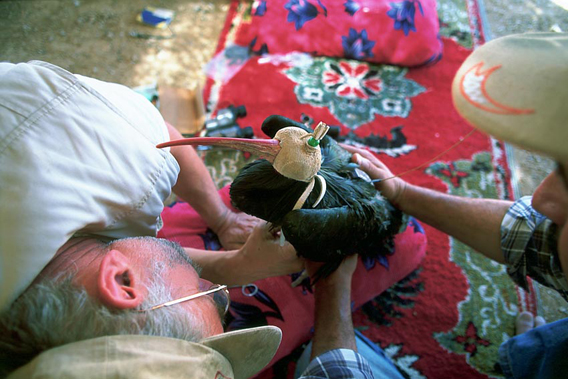
Lubomir Peske engaged in fitting a satellite tag to a northern bald ibis in Syria in spring 2006. Photo @ G. Serra.
In a remote corner of the Ethiopian highlands in January 2011, the bright tropical light combined with the fresh and thin air at 3,600 metres. The Ethiopian bird-watching guide and conservationist, Yilma Dellelegn, from the Ethiopian Wildlife Society, was startled when he spotted two un-ringed young bald ibises (Geronticus eremita), together with two ringed and well known adult females (Zenobia and Salam) at their wintering site.
Considering the dwindling numbers, two unaccounted for young birds, literally popping out of the blue, were a great surprise—and precious! The sighting had the potential to raise intriguing geographic and behavioral questions: in fact, the riddle of the migration and wintering strategy of the oriental northern bald ibis was still half way from being solved.
The international and diverse alliance of conservation organizations and experts I was a part of had so far managed to discover only a part of the mystery surrounding the hyper-threatened and tiny oriental population of bald ibises. The bird, until 2002, was considered extinct from the whole Middle East for a long time. That year, 3 breeding pairs were rediscovered in the Syrian desert of Palmyra, making media headlines internationally—the “Tutankhamen tomb of middle eastern ornithology” or “the rediscovery of the Arabian Phoenix, regenerated from its own ashes.”
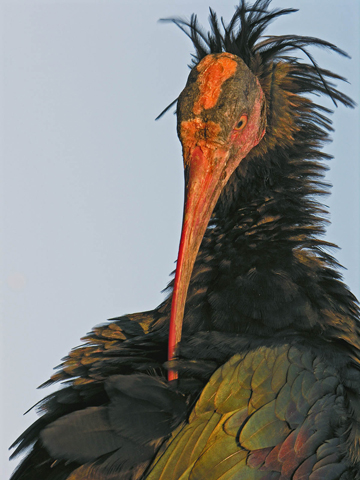 The peculiar features of the northern bald ibis: bald and red head, elongated and loose feathers of the hind neck and iridescent body plumage. Photo @ J. Crisalli. |
A few years after the discovery of the ibis colony in Palmyra, overcoming gigantic and grotesque political and bureaucratic obstacles, we managed to unveil the mystery about the migration route and wintering strategy of the adult breeders: a fantastic breakthrough achieved in 2006 thanks to the direct involvement of the Syrian First Lady and satellite telemetry technology. Conservationists and bird enthusiasts from all over the world could follow the progress of the migration online of the 3 tagged adults in July-August 2006 until they reached their wintering site in the Ethiopian highlands.
Only to discover that from a conservation perspective the other half of the story, the one concerning the immature ibises, was even more important: where do the juveniles roam during the 2-3 years they disappear to before returning to the natal site in Syria on reaching sexual maturity?
This was the ethological and conservation conundrum raised as early as 2007. The immature ibises would of course return to Palmyra only if they survived. The grim reality is that during the period of 2002-2010 we found that only 20% of immature birds managed to return safely to Palmyra, several years after their birth, a figure much lower than that observed in the closely related white stork, for instance.
This low return rate of young ibises contrasts with an 81% migratory return rate of adult ibises from the same colony, comparable to rates recorded in white storks. We have therefore come to realize that the high mortality of young ibises before returning to Palmyra may well be at the origin of the inexorable decline in the relict colony discovered in 2002: from 7 breeding adults in 2002 to 3 in 2010. The recruitment rate, insufficient to compensate for the natural mortality of adults, revealed that the intensive protection efforts at the Palmyra breeding grounds were insufficient to prevent the extinction of this last ibis colony of the Middle East.
The tiny and dwindling relict colony of Palmyra, together with the last 100 pairs still surviving in Morocco (belonging to the resident western population separated from the oriental one centuries ago), make up the whole global population for this species. Unsurprisingly, the IUCN’s Red List had listed this bird species as Critically Endangered (the highest threat level before extinction) on a global scale since 1994 and was also listed among the 100 most endangered animals of the planet during the recent IUCN World Conservation Congress. The northern bald ibis, since 2002, is the rarest bird in the Middle East.
Since the beginning we had feared that the key trait of this oriental ibis—the migratory crossing of some 10 countries twice a year for a total of 6,400 Km—was also behind the challenge to save it. In fact, it is much simpler to establish a conservation project aimed at rescuing a resident bird species or population, starting from few individuals survived: like what was done for their “cousins” in Morocco or for the “photographic negative” of the bald ibis, the crested ibis, in China (an ibis with almost the same appearance as the bald ibis, except for the white plumage).
Only in the U.S. has a long-range migratory bird species been successfully rescued starting from few individuals: the whooping crane, during the 1950-70s, was saved by establishing a solid partnership between government agencies and the civil society and thanks to sound funding.
The oriental bald ibis—today reduced to only 3 adult birds—is indeed a unique and charismatic animal. In addition to being fully migratory, unlike the western population, its awe-inspiring black flocks, in formation over the desert horizon, were contemplated with wonder by the successions of ancient civilizations, which have risen and fallen in the Middle East over the millennia.
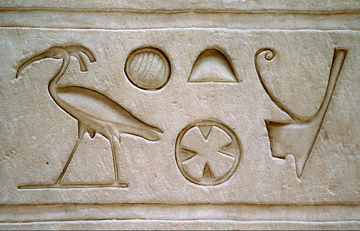 Hieroglyph from the Temple of Edfu, Egypt (ca. 250 BC), unmistakably depicting a northern bald ibis: according to ancient Egyptians this bird represented the divinity Akh accompanying the souls of the dead to the Afterworld. Photo @ A. Vándor. |
The handful of ibises still breeding in Palmyra are the last known living descendants of those revered by the ancient Egyptians and depicted on hieroglyphs from 4,500 years ago; and of the legendary bird mentioned in the Old Testament as “the fertility messenger” released by Noah from the Ark.
Until the 1980s, the most famous stronghold of this species in the Middle East was certainly the large colony returning every year to breed on the sandstone cliffs, on which the ancient fortress of the southern Anatolian village of Birecik is perched, along the Euphrates River in Turkey. This colony consisted of more than 1,000 birds around the 1950s, as reported by several travellers and ornithologists.
The local Muslim community heralded the beginning of spring with a traditional festival celebrating their migratory return in February. These same people believed since time immemorial, that bald ibises, through their summertime southward migration, guided and indicated the direction to be followed by the pilgrims bound to Holy Makkah.
High technology once more confirmed an ancient belief: astonished, thanks to satellite-tracking, we followed on Google Earth, three adult tagged ibises flying over Holy Makkah during their summertime 2006 migration! That year we followed these same birds until they reached their winter haven on the Ethiopian highlands, almost 4,000 meters above sea level, after having travelled some 3,200 kilometers from the breeding site of Palmyra.
We then reached the ibis wintering site “live,” by good use of satellite locations, GPS and a 4×4 vehicle, in the middle of nowhere on the highlands: a memorable and pure road-free and vehicle-free landscape; a timeless magic place without electricity, telephones, plastic and cement; inhabited by an agro-pastoral gentle people, the Oromo, living the same way since centuries if not millennia ago; a “Black Arcadia” where our birds live in harmony with the local community and unthreatened for almost six months of every year. That same winter we realized that only adult ibis breeders reach this Ethiopian site, while juveniles and sub-adults winter somewhere else.
The ibis colony in Birecik, belonging to the same genetic stock as the Syrian ibises, was decimated during the 1960s by the use of DDT in agriculture—northern bald ibis is in fact a voracious insect eater. But even by mitigating that deleterious threat later on, conservationists realized that fewer and fewer birds were coming back from migration in spring. In other words, as early as the 1980s, they realized that high mortality was affecting the last Birecik surviving birds along the migratory route or at their wintering grounds.
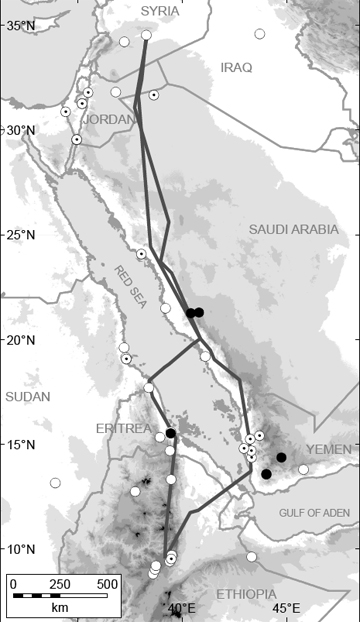 Migratory route of the oriental northern bald ibis as it was discovered in 2006 through satellite telemetry. Autumn southward journey to the east, spring northward journey to the west, each of them being about 3200 Km long. Map @ J. Lindsell. |
Due to this reason the few last wild surviving individuals from Birecik colony were placed into semi-captivity in 1989, preventing them from freely migrating—de facto sanctioning the formal “extinction from the wild” of this historical colony—and, as it was believed at that time, of the whole oriental ibis population.
Similarly, Syrian ibises appeared to be having troubles during their migration. In July 2009 we eventually had the “smoking gun” of what may drive the truly last surviving oriental ibis colony into extinction: uncontrolled hunting! In fact, a young female that we had tagged a couple of weeks earlier in Palmyra, named Julia, was shot on her very first day of migration, as soon as she reached the village of Tabarjal in northern Saudi Arabia (some 300 kilometers south of Palmyra).
Though the situation appears increasingly grim, we are still working toward a conservation miracle. Unveiling the second half of the mystery, the wintering strategy of the young ibises, would be a huge accomplishment enabling us to plan appropriate conservation measures. A key step in that direction would be to understand the orientation mechanism for fledged juveniles on their first migration southward. Due to conclusions drawn from past poorly-planned release trials, it was presumed that juveniles on first migration would follow their parents and learn the migration route from them—similar to the migratory behaviour of cranes.
Recent satellite tracking of juvenile and young ibises both from Syria and from Birecik (release trials of semi-captive birds) have shown that juveniles during their first migration have an “inner” knowledge of the correct migratory flying direction—without any need of learning it from their parents (the so called “genetic vector”).
On the other hand, one of these trials showed that juveniles are also able to follow adults, but not necessarily their parents, for a stretch of the migration. After which they are abandoned to their destiny—usually around the plains of south-western Saudi Arabia or coastal Yemen at about the halfway point in the migration. This complex pattern of migratory orientation, combining innate knowledge with learning (known as “social learning”), has recently been described for white storks migrating from Russia to eastern Africa.
We realized that it could be useful to carefully analyze opportunistic observations of bald ibises recorded in the region during the past 130 years. Italian and British military personnel made most “birdwatching observations” between the 1880s and World War II. Despite the gaps and ID mistakes typical of the so-called “grey literature” (unpublished, unverified accounts), this database contained nonetheless precious information waiting to be patiently extracted, decoded and evaluated, such as the unforgettable description by Captain Flower from the British Navy who saw “hundreds of bald ibises,” in migratory flying formation, following the course of the Blue Nile in February 1922.
Taken all together, historical records clearly show that in the past, the bulk of the oriental bald ibis population wintered on the Ethiopian highlands (as they do today). Young ibises were observed both during wintertime and during breeding time mostly in western Arabia. But some observations of young specimens were also recorded on the Ethiopian plateau, unlike today—thus raising the question: why would young ibises reach the Ethiopian plateau in the past and not today? Perhaps all scattered observations on young ibises made in recent years could be assembled like puzzle pieces and combined with disparate historical observations, in order to answer this intriguing question.
Until the 1970s, the oriental population of the northern bald ibis, composed by the large Birecik colony and the relatively large colonies from the Syrian desert, migrated southward during summertime using the route discovered in 2006, in discrete flocks—creating a “migratory flow” that was used as an orientation clue by both Muslim pilgrims and also juvenile ibises on their first migration. Young northern bald ibis could either fly on their own, relying on their innate knowledge of migratory direction, or follow adults for limited stretches of the migratory route.
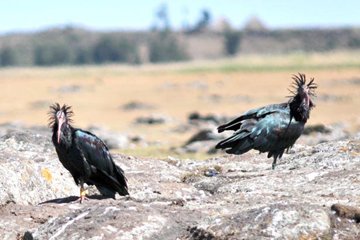 Two adult northern bald ibises photographed at their wintering site on the Ethiopian plateau in November 2008. Photo @ G. Serra. |
Through these means they were able to confirm the correct direction from the adult migratory “stream” southward—by simply waiting for the next flock of adults, and counting on the traditional use of stop-overing sites. These traditional stop over sites along the south-western Arabia coastal plains were most likely selected by experienced adult ibises, through the years, according to food availability and safety.
Young ibises have actually no other choice, being weaker fliers than adults: so they would follow adults, then stop and rest. And wait, like at a bus stop, to “intercept” another flock of adults passing by, sometimes days or weeks later. It is not difficult to imagine that some of them, the strongest and more motivated, would be able to reach the Ethiopian highlands and join the masses of adults congregated on the plateau.
Starting from the 1970s the whole oriental ibis population experienced a very rapid decline, becoming increasingly fragmented. Until reaching the current sad situation were only a handful of adults, still knowing the traditional migratory route, survived. The spectacular past ibis migratory flow over western Arabia, witnessed by British Captain T.E. Lawrence during his desert adventures, have long vanished. Muslim pilgrims are nowadays, prosaically, using charters and cars equipped with GPS in order to reach Holy Makkah.
As a consequence, the few young ibises lucky enough to fledge from Palmyra nowadays are unable to reach the Ethiopian plateau through social learning as in the past—strength and motivation aside. Instead they spend their first 2-3 years of life mostly in western Arabia (Saudi Arabia and Yemen)—possibly reaching eastern Africa on their own in mid-winter. Consistently, a juvenile born in Palmyra the previous spring was spotted alone by a group of Swedish birdwatchers—to their delight—on the Djibouti coast in January 2008.
Due to the dramatic population decline and lack of social learning during migration, young ibises today have no choice but to spend most of their time in western Saudi Arabia. An area with a high risk of hunting and also of electrocution by power lines, as recently observed during a National Geographic expedition. Immature birds are certainly more vulnerable to these threats than adults, due to their lack of experience, possibly explaining the differing mortality rates between young and adult specimens recorded in recent years and the low return rate of young ibis to Palmyra.
The exciting observation made a few months ago by Yilma—of the two un-ringed young ibises on the Ethiopian plateau – may fit well into the puzzle: they could have been subadult ibises, not sexually mature and therefore having not yet returned to Palmyra. They might have “intercepted” by luck the last two adult females in the Middle East at their traditional stop-over site in coastal Yemen last August 2010—while en route to Ethiopia—then followed them. Unfortunately they did not follow them to Palmyra next spring: did they perish during migration? Or were they not sexually mature enough to be motivated to return to Palmyra?
The geographic and behavioral mysteries surrounding the last oriental ibises seem to be close to a final explanation. A question naturally arises though: is time running out for saving this endangered and unique bit of the planet’s biodiversity heritage? An unpredictable setback has been the war that has erupted in Syria during the last year. As a consequence, no international assistance to local Syrian authorities, in relation to the implementation of the annual ibis protection program, could take place this spring at the breeding grounds in Palmyra.
It turned into an unplanned “sustainability test” for the project: we were happy to see that the local authorities and trained rangers coped well with the protection of the breeding birds and two chicks have fledged successfully. On the other hand, it is a fact that the Syrian First Lady had been instrumental in supporting the ibis conservation cause during the past years: what would be the implications for our project if there is a change of political leadership in the country?
Surely, the recent realization that immature ibises can migrate independently from adults holds an important conservation implication: captive-born juveniles of Turkish origin could be released at the Syrian wild colony in Palmyra for the sake of supplementing it (Turkish and Syrian birds clearly belonged to the same wild population until the 1980s). To our delight, a test, the first of this kind, was successfully undertaken in 2010 in Palmyra, thanks to an extraordinary diverse international partnership.
At the same time, we are now aware that to reduce the mortality rate of immature birds, conservation efforts should be focused along the migratory route in western Arabia. This will benefit not only ibises, but another six globally threatened and four declining migratory bird species sharing the same flyway. What we really hope is that we are not documenting the extinction of this legendary population of birds. The recent detection by Yilma of the two immature birds on the Ethiopia highlands is indeed encouraging news: perhaps there are more immature ibises than we thought, still surviving and roaming across Arabia and eastern Africa?
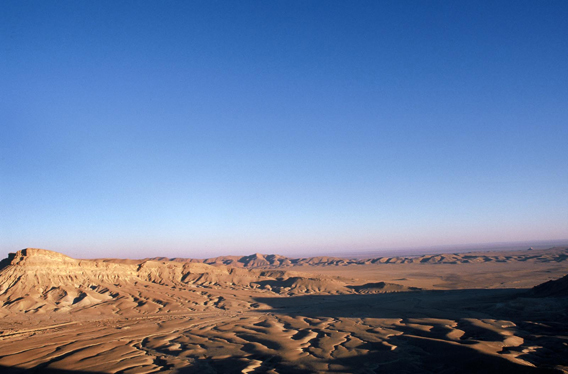
Panoramic overlook of the northern bald ibis breeding grounds in the Syrian desert. Photo @ G. Serra.
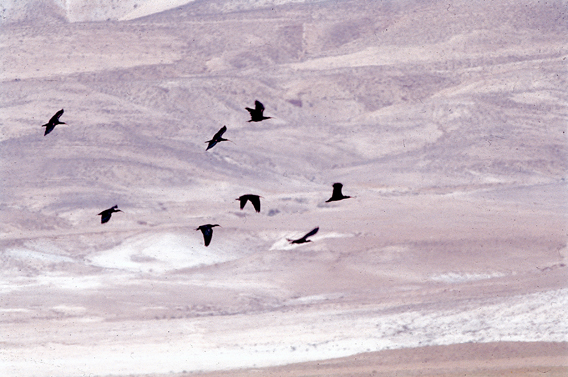
The last flock of northern bald ibis, belonging to the eastern population, flying over the Syrian desert in spring 2003. Photo @ G. Serra.
Dr. Gianluca Serra is an animal ecologist, conservation biologist and practitioner interested in endangered species and protected areas management.
For more insights on the conservation saga of the eastern population of northern bald ibis see also Another vanishing species—Northern Bald Ibis in the Middle East.
Acknowledgements: The project is a joint effort of the General Commission for Badia Management and Development in Syria, IUCN West Asia, BirdLife Middle East and the Royal Society for the Protection of Birds. Funds were made available by the Italian Development and Cooperation Bureau (DGCS), Monaco Foundation, National Geographic Society and RSPB.
Related articles
Photo: high-altitude bird rediscovered after 80 years
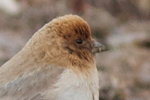
(10/29/2012) In 1929 the U.S. Stock Market collapsed, the Geneva Convention set standards for prisoners of war, the first Academy Awards was celebrated, and Jérôme Alexander Sillem collected two bird specimens on a high plateau in Xinjiang, China. For 62 years, the specimens sat in a drawer at the Zoological Museum of Amsterdam until C. S. Roselaar found them, studied them, and determined they, in fact, represented a new species of bird: Sillem’s mountain finch (Leucosticte sillemi). Now, 83 years after Sillem collected the only known specimens, a French photographer, Yann Muzika, unwittingly took photographic proof that the finch species still survives.
Saving the world’s species from oblivion will cost around $80 billion a year, but still a good deal
(10/11/2012) If the world is to conserve its wealth of life—species great and small, beautiful and terrible, beloved and unknown—it will cost from $3.41-4.76 billion annually in targeted conservation funds, according to a new study in Science. But that’s not all, the cost of protecting and managing the world’s conservation areas was estimated at an additional $76.1 billion a year.
Parrots of the Caribbean: extinction looms in the Bahamas
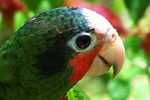
(10/08/2012) I think about extinction a lot. It’s only natural for someone in my line of work. On my way to work I drive past the Colorado National Monument. Even from a distance it’s impressive: piles of dark schist 1,500 million years old; Wingate sandstone from the age of dinosaurs, all of it formed into cliffs, carved into spires. I can see Independence monument from the highway; a tall tower of tan sandstone that John Otto climbed near the beginning of the 20th century without rope. The monument is a display of the massive changes in the world. I often think about the rainforests and the oceans that once covered the land. Ecosystems have come and gone, the planet destroyed and rebuilt over and over.
Penguins face a slippery future
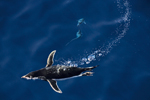
(09/26/2012) Penguins have spent years fooling us. With their image seemingly every where we turn—entertaining us in animated films, awing us in documentaries, and winking at us in commercials—they have made most of us believe they are doing just fine; the penguin’s charming demeanor has lulled us into complacency about their fate. But penguin populations are facing historic declines even as their popularity in human society rises. Overfishing is decimating some of their prey species, climate change is shifting their resources and imperiling their habitat, meanwhile pollution, such as oil spills, are putting even healthy colonies at risk. Now, a young organization, the Global Penguin Society (GPS), is working to save all of the world’s 18 penguin species by working with scientists, governments, and local communities.
Arachnopocalypse: with birds away, the spiders play in Guam

(09/17/2012) The island of Guam is drowning in spiders. New research in the open-access journal PLOS ONE has found that in the wet season, Guam’s arachnid population booms to around 40 times higher than adjacent islands. Scientists say this is because Guam, a U.S. territory in the Pacific, has lost its insect-eating forest birds. Guam’s forests were once rich in birdlife until the invasion of non-native brown tree snake (Boiga irregularis) in the 1940s decimated biodiverse bird communities. Now, the island is not only overrun with snakes, but spiders too.
Rare birds abound in Brazil’s Acre state
(09/17/2012) The Brazilian state of Acre has had little attention by bird-lovers and bird scientists, though it lies deep in the Amazonian rainforest. Now a new survey in mongabay.com’s open access journal Tropical Conservation Science by ornithologist, John J. DeLuca, works to build a better picture of rare birds in this largely-neglected region. The work is all the more important as the Brazil-Peru Interoceanic Highway could bring massive changes to the region.